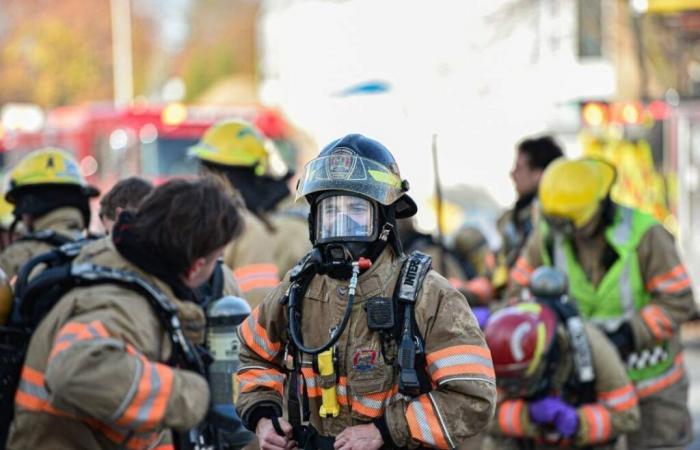With the growing popularity of electric vehicles – whether automobiles, bikes, scooters or scooters – powered by lithium ions often recharged inside dwellings, the risk of fire linked to these devices is clearly increasing. These batteries, in the event of failure, can cause a thermal runoff that can go as far as explosion, causing significant material damage and clearing toxic smoke. Faced with these dangers, firefighters from the Fire Security Service of the Longueuil Agglomeration (SSIAL) received specialized training in order to intervene effectively during fires involving this type of technology.
The warning signs of a thermal runaway are the release of heat, the swelling of the battery, the release of smoke and a crackling or a whistling. “In all cases, there will be projection of debris and flames in pressure under pressure,” says Daniel Deslauriers, head of division for training, operations and health and safety at work in the SSIAL.
Growing popularity
Supporting figures, Mr. Deslauriers indicates that 44% of electric vehicles in the country run in Quebec, which represents 337,844 vehicles, according to data from the Quebec electric vehicle association dated September 2024.
It is in Montérégie that we find the highest electrification rate of the fleet. “It is not surprising to see more and more in the Agglomeration of Longueuil. And it is in counting electric vehicles passing through, ”observes Mr. Deslauriers.
In 2024, the SSIAL intervened on a dozen fires caused by batteries with lithium ions. “You should know that it is only recently that we started to count them. But over the years, we expect an increase. This is why training was necessary for our teams to acquire the skills necessary to intervene effectively, ”said the firefighter.
Tactics
Firefighters use various tactics depending on the nature of the fire involving one or more batteries with lithium ions: the use of large quantities of water for large batteries, immersion in water in a container or even a bathtub for smaller batteries.
When required, in order to reduce propagation to a building or other vehicles, firefighters may use fireproof coverage for the burnting electric vehicle. “Coverage will be able to reduce propagation, but will not be able to extinguish it completely. Only water is effective in fire extinction, ”says Deslauriers.
Safety question due to intense heat, risk of explosion and toxic gas, a radius of 100 feet is still respected for an electric motor vehicle while it is only 50 feet for petrol vehicles.
Advice
The main safety tips related to lithium ions are to cease any use if the battery deforms, changes color or emits an unusual odor, to use approved spare batteries, to avoid exposing batteries to potential heat or water and to avoid overloading electric sockets.
One of the security advice regarding batteries with lithium ions is never to let it recharge without supervision. (Photo – graciousness)
“Also, never let the battery recharge unattended,” insists Mr. Deslauriers.
Lithium ion batteries are known to turn on unexpectedly in a few minutes, hours or even days, after any visible fire was extinguished.
This phenomenon is common, even if they have been overwhelmed. This is why a vehicle with a battery with burnt lithium ions should be isolated.
Outward
For optimal storage of the electric scooters and bikes, it is recommended to keep them outside, in a secure shelter, for example a garage or shed detached from the house or a covered and lockable bicycle shelter.
If the interior is the only option, store near an outing to facilitate rapid evacuation, in a well -ventilated room, far from flammable materials, never in corridors, stairs or evacuation tracks and never in bedrooms.
According to the SSIAL, any battery which overheats or which releases smoke during recharge, any battery which seems damaged or abnormal, which is used in a damaged vehicle significantly and any battery in thermal runaway must be disconnected and carried to the eco -centered.








